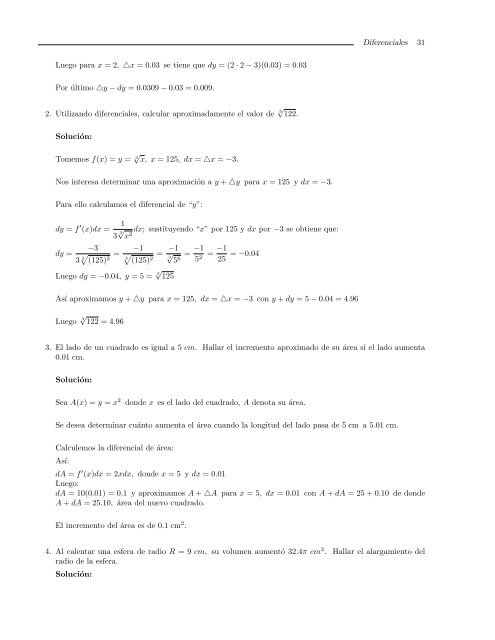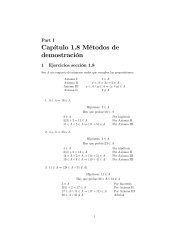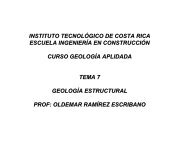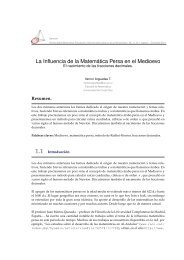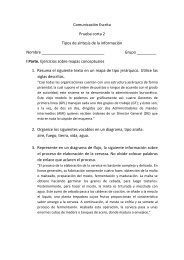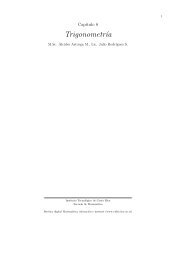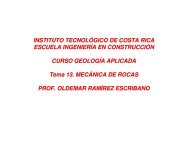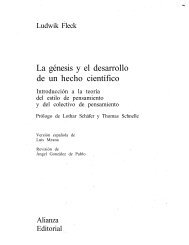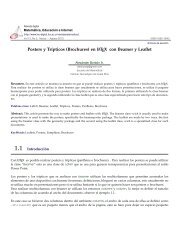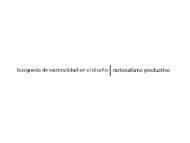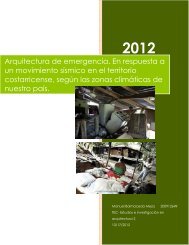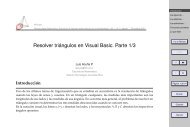Derivada de una función - TEC-Digital
Derivada de una función - TEC-Digital
Derivada de una función - TEC-Digital
Create successful ePaper yourself
Turn your PDF publications into a flip-book with our unique Google optimized e-Paper software.
Luego para x = 2, △x = 0.03 se tiene que dy = (2 · 2 − 3)(0.03) = 0.03<br />
Por último △y − dy = 0.0309 − 0.03 = 0.009.<br />
2. Utilizando diferenciales, calcular aproximadamente el valor <strong>de</strong> 3√ 122.<br />
Solución:<br />
Tomemos f(x) = y = 3√ x, x = 125, dx = △x = −3.<br />
Nos interesa <strong>de</strong>terminar <strong>una</strong> aproximación a y + △y para x = 125 y dx = −3.<br />
Para ello calculamos el diferencial <strong>de</strong> “y”:<br />
dy = f ′ (x)dx = 1<br />
3 3√ dx; sustituyendo “x” por 125 y dx por −3 se obtiene que:<br />
x2 −3<br />
dy =<br />
3 3 −1<br />
= <br />
(125) 2 3 (125) 2<br />
= −1<br />
3√ 5 6<br />
Luego dy = −0.04, y = 5 = 3√ 125<br />
−1 −1<br />
= = = −0.04<br />
52 25<br />
Así aproximamos y + △y para x = 125, dx = △x = −3 con y + dy = 5 − 0.04 = 4.96<br />
Luego 3√ 122 = 4.96<br />
Diferenciales 31<br />
3. El lado <strong>de</strong> un cuadrado es igual a 5 cm. Hallar el incremento aproximado <strong>de</strong> su área si el lado aumenta<br />
0.01 cm.<br />
Solución:<br />
Sea A(x) = y = x 2 don<strong>de</strong> x es el lado <strong>de</strong>l cuadrado, A <strong>de</strong>nota su área.<br />
Se <strong>de</strong>sea <strong>de</strong>terminar cuánto aumenta el área cuando la longitud <strong>de</strong>l lado pasa <strong>de</strong> 5 cm a 5.01 cm.<br />
Calculemos la diferencial <strong>de</strong> área:<br />
Así:<br />
dA = f ′ (x)dx = 2xdx, don<strong>de</strong> x = 5 y dx = 0.01<br />
Luego:<br />
dA = 10(0.01) = 0.1 y aproximamos A + △A para x = 5, dx = 0.01 con A + dA = 25 + 0.10 <strong>de</strong> don<strong>de</strong><br />
A + dA = 25.10, área <strong>de</strong>l nuevo cuadrado.<br />
El incremento <strong>de</strong>l área es <strong>de</strong> 0.1 cm 2 .<br />
4. Al calentar <strong>una</strong> esfera <strong>de</strong> radio R = 9 cm, su volumen aumentó 32.4π cm 3 . Hallar el alargamiento <strong>de</strong>l<br />
radio <strong>de</strong> la esfera.<br />
Solución:


